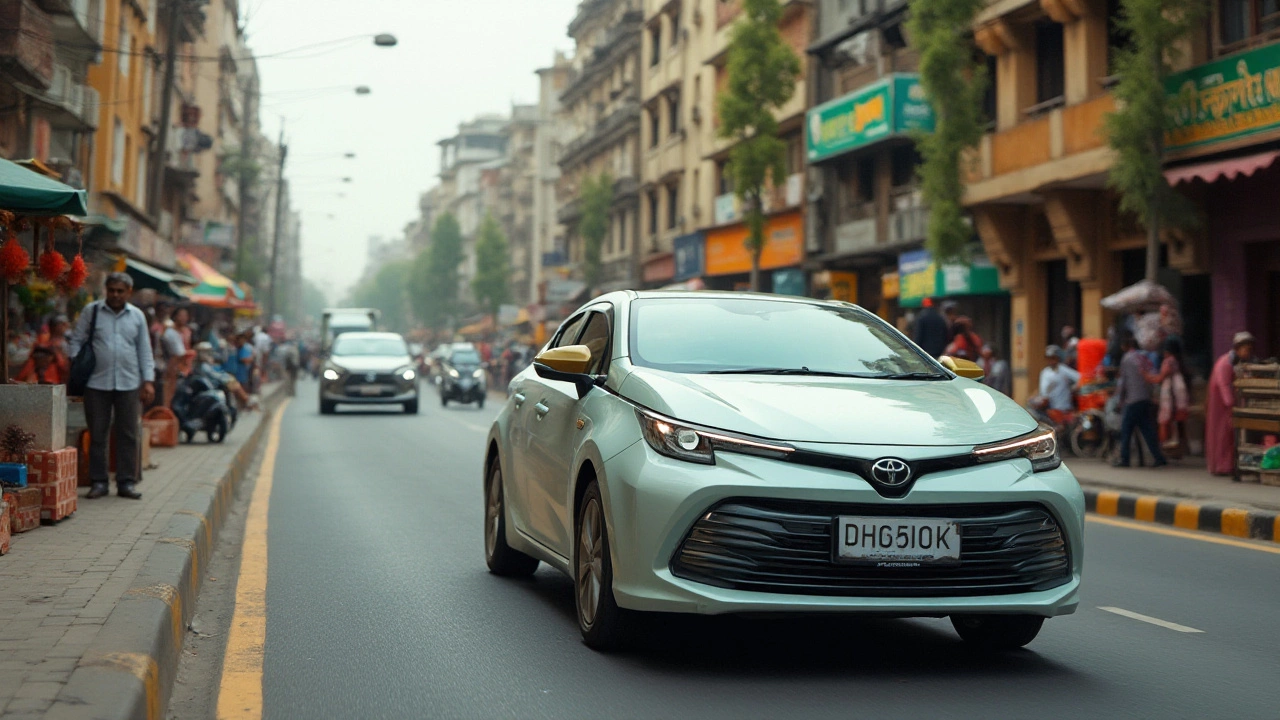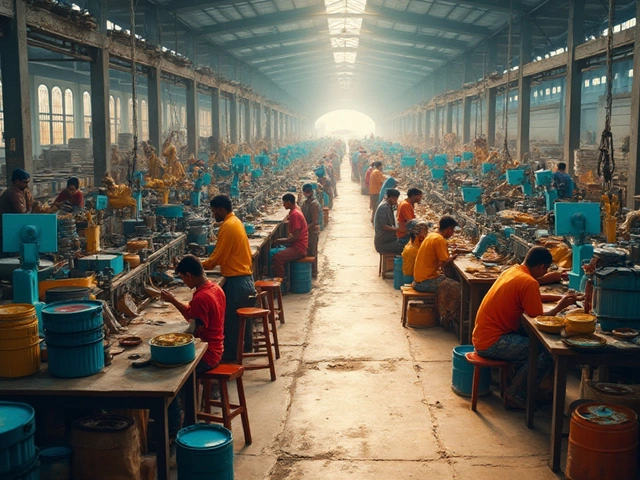India is a bustling hub of automotive manufacturing, and a name that has made a mark here is Toyota. The Japanese automaker is known worldwide for its reliable and efficient vehicles, and in India, it has carved out a substantial presence. But what exactly does Toyota's manufacturing presence look like in this expansive and varied market?
In this article, we'll explore how Toyota has woven its way into the Indian automobile fabric through strategic manufacturing initiatives. From modern facilities to innovative approaches, we'll dive into the nitty-gritty of how this automotive giant functions in India. Whether you're curious about their local vehicle lineup or how they contribute to employment in the region, this exploration will provide valuable insights.
- Toyota's Operations in India
- Manufacturing Facilities and Capabilities
- Economic Impact and Innovations
- Future Prospects and Challenges
Toyota's Operations in India
In the dynamic landscape of the Indian automobile industry, Toyota stands as a significant player, not just as a vehicle manufacturer but as a symbol of technological prowess and innovation. Toyota entered the Indian market in the late 1990s through a joint venture with Kirloskar Group, establishing the brand Toyota Kirloskar Motor Private Limited (TKM). This strategic move allowed Toyota to harness local expertise while introducing its renowned global practices, a synergy that laid the groundwork for its robust operations within the country.
The company's primary manufacturing plant is located in Bidadi, Karnataka, where it undertakes extensive vehicle assembly. This plant is one of the most advanced in the region, known for its use of lean manufacturing processes that minimize waste and maximize efficiency. With an eye on sustainability, TKM has implemented a range of green initiatives, including the use of solar energy to power sections of their operations, underscoring their commitment to reducing their carbon footprint.
According to a report, Toyota has invested heavily in this plant, making it one of the few facilities in India to achieve such high levels of automation and precision. A significant percentage of the components used in manufacturing are sourced locally, supporting domestic suppliers and boosting the Indian economy. The Bidadi plant employs thousands of workers, providing steady jobs and contributing significantly to local economic development. A senior Toyota executive once noted, "Our goal in India is to balance global quality with local affordability, ensuring our vehicles are both renowned for their excellence and accessible to our valued customers."
Regarding their lineup, Toyota offers a blend of globally successful models and India-specific vehicles. This includes everything from compact cars like the Glanza to robust SUVs such as the Fortuner, a favorite among Indian consumers for its durability and performance. Toyota has managed to cater to a broad spectrum of customers, reflecting an understanding of local demands and preferences. The company's strength lies in its ability to adapt and innovate, regularly updating its models to incorporate the latest technology and meet evolving consumer needs.
Moreover, Toyota's operations in India are not limited to just manufacturing and sales. TKM is deeply involved in Corporate Social Responsibility (CSR) initiatives, focusing on areas such as education, road safety, and health hygiene. The company runs several educational programs aimed at empowering local communities. Such initiatives are integral to Toyota's philosophy of contributing positively to the societies in which they operate, reinforcing their image as a responsible corporate citizen.
A look at Toyota's operations shows a strategic focus on creating a lasting impact. With strong local partnerships, ongoing investments in technology, and a comprehensive focus on sustainability and community engagement, Toyota's footprints in India are marked by both corporate success and social responsibility. As the industry shifts towards electrification and sustainability, Toyota's commitment to innovation and adaptability positions it as a formidable player in the future of Indian automotive manufacturing.

Manufacturing Facilities and Capabilities
It's fascinating to delve into how Toyota has established its manufacturing capabilities in India, a country with diverse challenges and opportunities. The company's operations in India are primarily conducted through its joint venture, Toyota Kirloskar Motor Private Limited (TKM), which was set up to cater to the rising demand for automobiles in the subcontinent. TKM operates two prolific manufacturing plants situated in Bidadi, near Bangalore. These facilities are credited with producing a range of Toyota cars in India, including popular models like the Fortuner and Innova Crysta – vehicles deeply admired for their durability and innovation.
The first plant, operational since 1997, set the foundation for Toyota's robust manufacturing standard in the region. It boasts a production capacity of about 100,000 units annually. This plant primarily focuses on assembly operations, incorporating best practices from its parent company's global production ethos, which emphasizes lean manufacturing and efficiency. The second plant, which came online in 2010, added another 210,000 to the annual capacity, expanding Toyota's ability to meet domestic and international demands. This expansion was driven by a strategic goal to localize production extensively, thereby minimizing costs and supporting the Indian automobile ecosystem.
A critical factor in Toyota's manufacturing success is its commitment to integrating technology and sustainable practices. Both plants are proficient in adhering to stringent environmental standards, integrating renewable energy sources wherever possible, which aligns with global sustainability objectives. This attention to environmental responsibility enhances Toyota's image as a forward-thinking brand in the automobile industry India. A significant chunk of the production process is now automated, driving precision and minimizing human error, which is vital for maintaining quality consistency across thousands of units.
Toyota invests heavily in its workforce, ensuring that they are well-trained and highly skilled, which contributes significantly to the company's capability to produce high-quality vehicles. Regular training sessions and skill development programs are integral components of their human resource strategies. These initiatives are not just technical; they also place emphasis on Toyota's core philosophy known as “Toyota Way,” which fosters a culture of innovation and efficiency.
According to Masakazu Yoshimura, Managing Director of Toyota Kirloskar Motor, "The success of our manufacturing facilities in India lies in our unwavering commitment to sustainable and eco-friendly practices, innovative production techniques, and the relentless drive of our skilled workforce."
The extent of localization in Toyota’s manufacturing process is also impressive. Nearly 85% of the components used in locally-manufactured vehicles are sourced domestically, ensuring that the benefits of production trickle down to the local supply chain. This localization strategy not only supports local businesses but also helps reduce the overall cost of vehicles, making them accessible to a wider audience. This is an essential aspect of Toyota’s strategy in ensuring that it maintains a competitive edge in the crowded and price-sensitive Indian automotive market.
Therefore, Toyota's manufacturing facilities in India are not just industrial sites but microcosms of the company's larger philosophy. They are where ideas of precision manufacturing, environmental care, and local engagement are crafted into every Toyota vehicle that rolls off the assembly line. These plants serve as testament to Toyota's adaptability and commitment to producing some of the best Toyota cars in India. Such efforts not only strengthen their position in the automotive sector but also contribute significantly to the overall industrial landscape of India.

Economic Impact and Innovations
In the dynamic landscape of the Indian automobile market, Toyota plays a pivotal role not just as a manufacturer but as a key driver of economic growth. The company's operations have had substantial ripple effects across various sectors, contributing significantly to the GDP and employment in the regions where its plants are located. One of the most noteworthy aspects of Toyota's manufacturing in India is its partnership model, which emphasizes collaboration with local suppliers. This approach not only bolsters the domestic auto component industry but also ensures quality control and cost efficiency, key factors in Toyota's global success.
The company's focus on sustainability stands out as a hallmark of its innovative spirit. Toyota has pioneered several eco-friendly initiatives in its Indian plants, harnessing renewable energy sources such as solar power to reduce its carbon footprint. This is particularly important in a market where environmental concerns are increasingly influencing buying decisions. Additionally, the introduction of hybrid models in the Indian market underscores Toyota's commitment to greener technologies, aligning with global trends towards sustainable mobility. These innovations reflect Toyota's strategy to not only serve the present market demands but also anticipate and shape the future landscape of automotive technology.
A quote from a leading industry expert succinctly captures the essence of Toyota's dual focus on economic impact and sustainable innovation:
"Toyota's manufacturing excellence in India stands as a beacon of integrating economic viability with environmental responsibility. Their approach is a benchmark for the industry on how to thrive in a competitive market while committing to a greener planet."This alignment of economic and ecological objectives is not only a competitive advantage for Toyota but also a pathway that inspires other manufacturers in the region.
To illustrate the economic impact in tangible terms, consider a hypothetical breakdown of employment statistics related to Toyota's Indian operations. For instance, according to recent industry reports, Toyota's direct and indirect employment in the country supports thousands of families, providing not just jobs but a viable career path for many in the automotive supply chain. These opportunities extend beyond the assembly line, encompassing areas like research and development, which is increasingly becoming a focal point for Toyota in India as it seeks to tap into the rich pool of engineering talent available in the country.
As Toyota continues to evolve, its focus on local and sustainable innovation will likely grow even stronger, driven by changing consumer expectations and regulatory landscapes. This adaptability and foresight will undoubtedly play a crucial role in defining the future of automotive manufacturing in India, ensuring that Toyota remains not just a manufacturer but a leader and trendsetter in the Indian automobile industry.

Future Prospects and Challenges
Looking ahead, Toyota's journey in the Indian automobile sector appears promising yet intertwined with a unique set of challenges. As the company navigates the evolving landscape, there's an increasing emphasis on sustainable mobility solutions that can cater to India's ambitious environmental goals. Exploring opportunities in electric vehicles (EVs) and hybrid technology, Toyota aims to align itself with the global shift towards greener alternatives. Such innovations aren't just about meeting regulatory requirements; they are also about tapping into a growing consumer base that's becoming increasingly conscious of its carbon footprint.
One of the notable challenges is the burgeoning competition in the Indian market. Local and international manufacturers alike are keen on carving out their share of a population with rapidly changing economic statuses and preferences. Toyota must continually innovate and adapt to sustain its position. Investments in research and development will be crucial as the battle for market leadership heats up. The company's strategy might involve strengthening its local partnerships and supply chain to improve cost efficiencies and maintain competitive pricing structures.
There's also the task of enhancing infrastructural capabilities to support the envisioned growth. Expanding production capacities and optimizing existing facilities are imperative as Toyota seeks to increase its production volume and reduce lead times. Addressing logistic challenges in India, known for its diversified rural and urban scapes, is another key area. Toyota could benefit from the improved logistics networks that have been on the national agenda, aimed at boosting economic activities and reducing bottlenecks in product movement.
Regulatory changes and policy shifts remain significant factors influencing Toyota's prospects. India's regulatory landscape, with its stringent emissions norms and safety standards, requires continuous adaptation and compliance. Toyota's global expertise in managing these dynamics might provide a competitive edge, yet it necessitates constant vigilance and agility. Adapting to these policies while ensuring the products remain affordable to the average Indian consumer forms a delicate balance that Toyota needs to maintain.
"The journey of Toyota in India is marked by innovation and adaptation," said a spokesperson from the Indian automobile industry. "Their commitment to future-ready solutions while navigating the local challenges sets a benchmark for other manufacturers."The quote sums up Toyota's ongoing efforts to evolve in a rapidly transforming market. A large part of its strategy may include collaborations with technology firms for next-gen automotive solutions capable of integrating features like IoT, AI, and automation that are slowly becoming intrinsic to consumer expectations.
Ultimately, Toyota's future in India hinges on its ability to marry tradition with innovation. Leveraging decades of industry leadership while embracing new paradigms will shape its path forward. As the world watches the Indian automobile sector unfold, Toyota remains a critical player with the potential to drive sustainable growth both for itself and the broader economy.





Write a comment